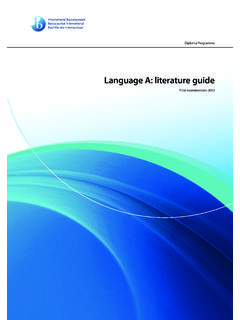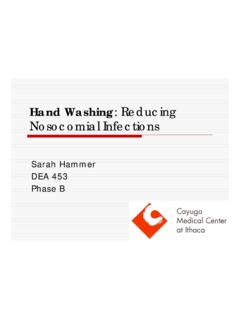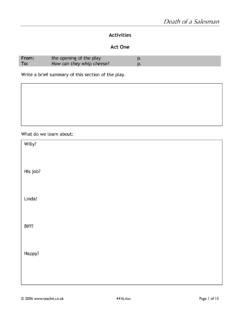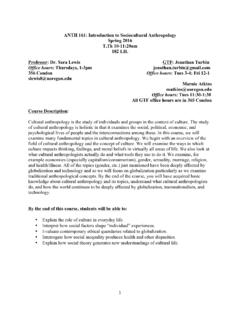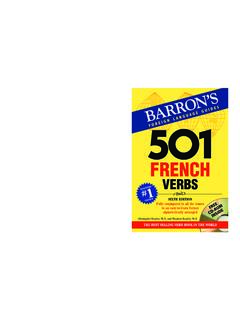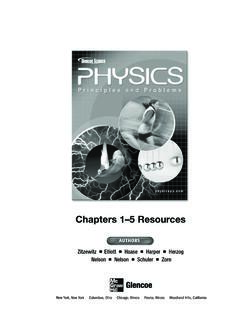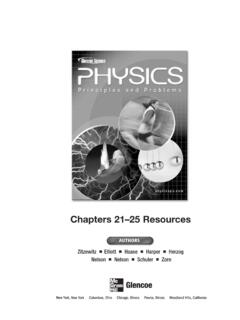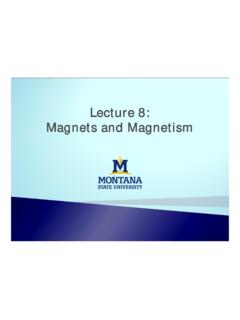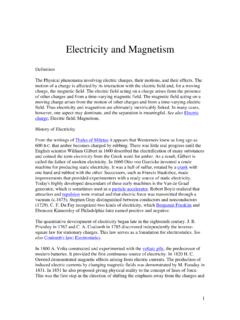Transcription of Introduction to Electricity & Magnetism
1 Dr Lisa Jardine-WrightCavendish LaboratoryIntroduction to Electricity & MagnetismExamples of uses of lightsHuman bodyElectronic devicesCarsElectricity? Electricityis the presence and motion of charged particles. Electric currentis the flow of charged particles around an closed path an electric Charge There are two types of charge, which are labeled positiveand negative. Like charges repel, Unlike charges attract. Charge is never created or destroyed. Electric Charges Charge arises because of a transfer of electrons. This charge, measured in units called Coulombs (C), is given by To charge an object means to transfer electrons from one object to another. They are not created or destroyed, just moved! an on Charge19 =Electric Forces & Charge If an electrical force moves a charge a certain distance, it does work on that charge.
2 The work doneby this force:Work done = charge x potential difference, W = QV Potential differenceis the voltage dropacross two points. Units of voltage = Volts (V)Electric Current Electric currentis the charge flowing through a point per unit time. Current = Charge / TimeI= Q / t Unit of current = Amp res (A) Two types of current in everyday life: Direct current (DC)and alternating current (AC)Electrical Resistance Ohm's lawstates that, in an electrical circuit, the current passing through a conductor between two points is directly proportionalto the potential differenceacross the two points. (providing physical conditions remain constant). Units of resistance = Ohms ( )Electrical Symbols & UnitsLampResistorCellSwitchVoltage =Volts (V)Resistance =Ohms ( )Voltage, Current & ResistanceV +-IRV = Ix RRV=IElectrical Conductivity Good electrical conductors, such as copper, have a low resistance.
3 Poor electrical conductors, such as concrete, have a high resistance. Currentis the flow of the outer electrons of atoms through the material. Resistance then results from collisions of electrons with other electrons and with atoms. Solids:Insulators -vs- Conductors Atomic structure of a solid: A latticeSolids:Insulators -vs- ConductorsElectrons in the latticeINSULATORCONDUCTORB ound to atomsFree to moveElectric CircuitsConnecting in SeriesV+-R1 Total R = R1+R2+R3I = I1= I2= I3I= V/R = V/(R1+R2+R3 )R2R3I1II2I3 IConnecting in Parallel321R1R1R1R1++=VR1R2R3I+-Total R:I1I2I3II = I1 + I2 + I3RV=Series -vs- Parallel+-1 2 3 I6V6VI+-1 2 3 I1I2I3I3I2I1V I +-I1I2 SaIntroducing a SwitchPredict the Action of The Switches Sa -SdV +-SaSdScSbPredict the Action of The Switches Sa -SdV +-SaSdScSbPredict the Action of The Switches Sa -SdV +-SaSdScSbPredict the Action of The Switches Sa -SdV +-SaSdScSbPredict the Action of The Switches Sa -SdV +-SaSdScSbPredict the Action of The Switches Sa -SdV +-SaSdScSbPredict the Action of The Switches Sa -SdV +-SaSdScSbPredict the Action of The Switches Sa -SdV +-SaSdScSbPredict the Action of The Switches Sa -SdV +-SaSdScSbPredict the Action of The Switches Sa -SdV +-SaSdScSbPredict the Action of The Switches Sa -SdV +-SaSdScSbPredict the Action of The Switches Sa -SdV +-SaSdScSbPredict the Action of The Switches Sa -SdV +-SaSdScSbPut Lamps 1-5 in Order of
4 BrightnessV +-23451 Put Lamps 1-5 in Order of BrightnessV +-23451 Making ElectricityHow Do Cells Work?Electrodes (uncharged) made with different metalsElectrolyte: ionic solutionHow Do Cells Work ?electrode negatively chargedpositive ions that pass into solutionHow Do Cells Work?AI 0 IonsElectronsThe Orange CellAI ??? Magnetism Natural magnets have North and South Poles. Like poles repel and opposite poles attract. Magnetic field lines flow from North to South. Natural magnets are made from Iron, Nickel, and Cobalt. Magnetic substances can be induced by magnets to become Dynamo A dynamoconverts kinetic energy into electrical energy through electromagnetic Field Around a WireLenz s Law and Induction Lenz's lawenables us to determine the direction of theinduced current:"The direction of the induced current is such as to oppose the change causing it.
5 "Inducing a Current in a CoilInducing a Current in a Coil Size of the electromotive force (voltage, V ) in a coil depends on: The strengthof the magnet , B the cross-sectional areaof the coil, A the number of loopsin the coil, N And its frequencyin or out of the coil, fBANfV=Making an Electromagnet If you wrap a wire around an iron core, such as a nail, and you send electrical current through the wire, the nail will become highly magnetized. Electricity Summary Relation between voltage, current and resistance Resistors in series Resistors in parallelV = Ix RTotal R = R1+R2+R3321R1R1R1R1++= Magnetism Summary A dynamoconverts kinetic energy into electrical energy through electromagnetic induction. Lenz s Law -"The direction of the induced current is such as to oppose the change causing it." Size of the electromotive force (voltage, V ) for a magnetically induced currentBANfV=

